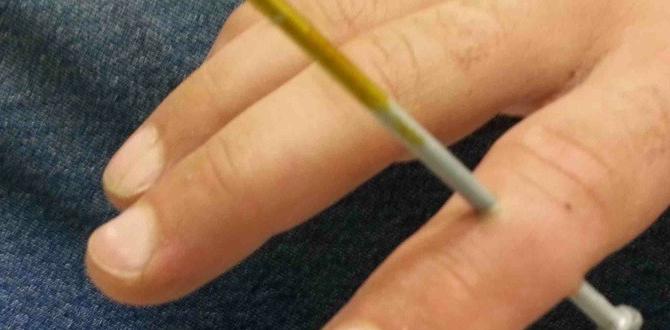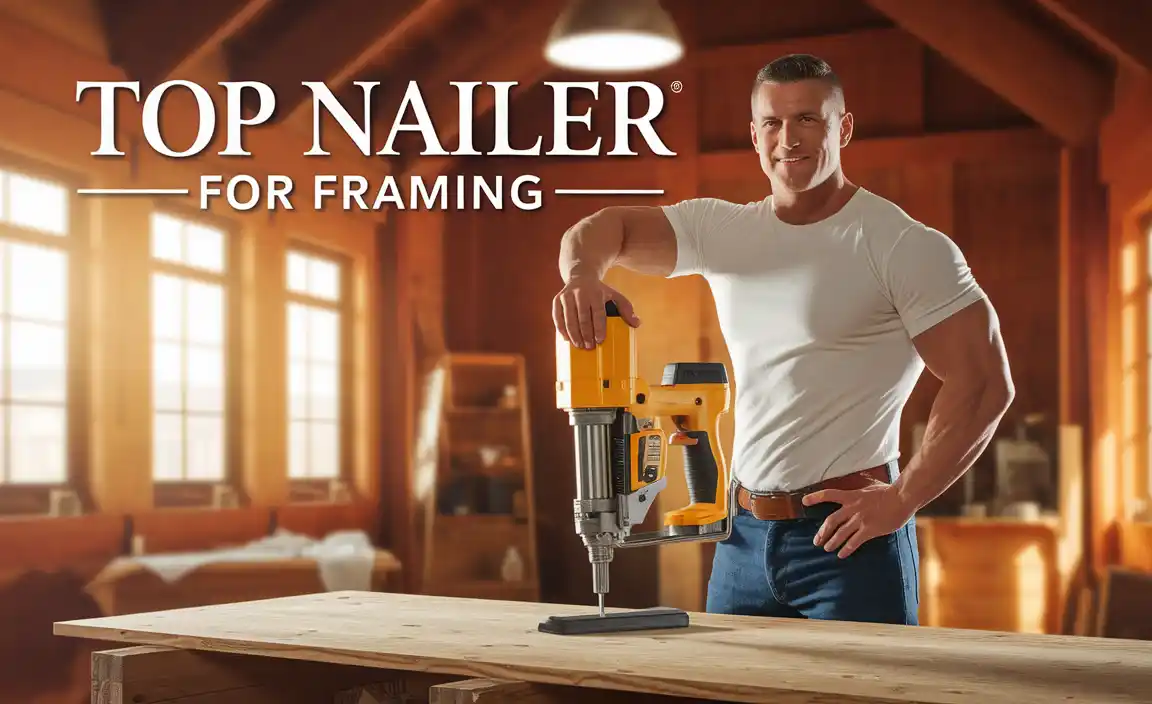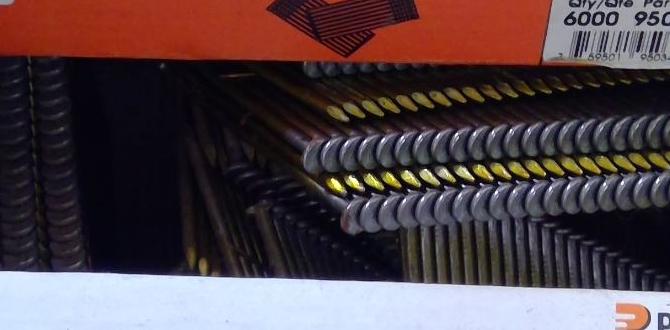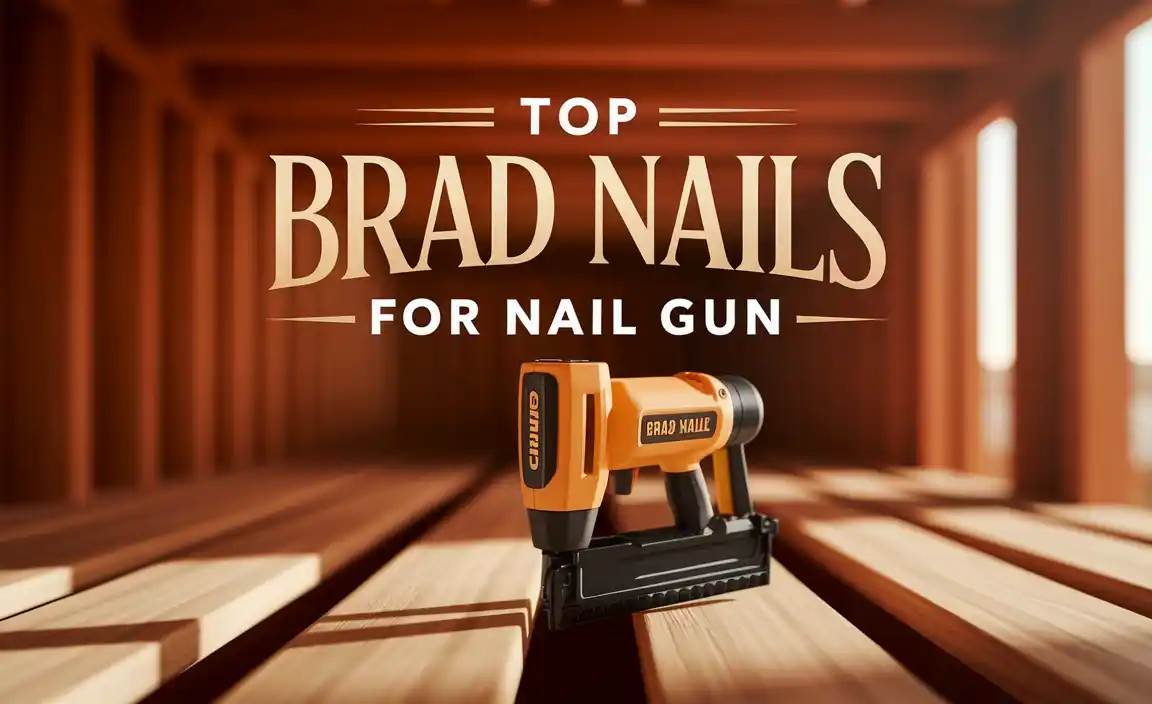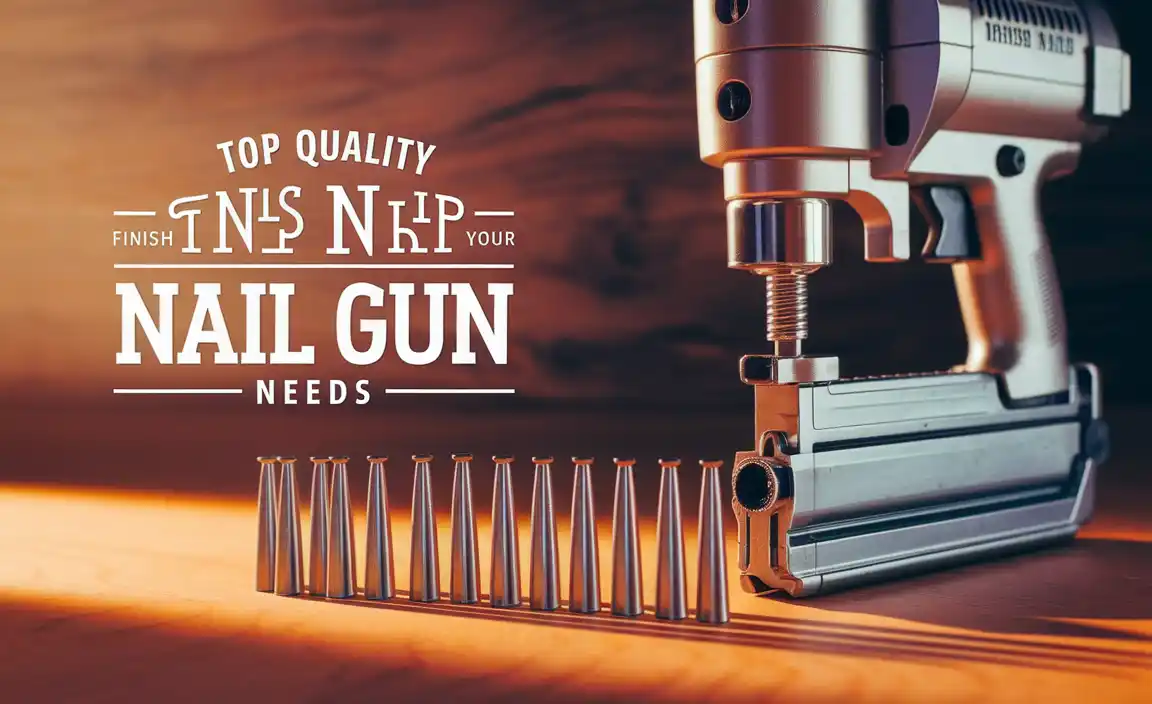Have you ever tried to build something at home? Maybe a birdhouse or a bookshelf? Picking the right tools can make a big difference. One tool that many beginners find helpful is the nail gun.
But how do you choose the best nail gun for yourself? With so many options, it might feel overwhelming. What if you could build with confidence? Understanding nail guns is the first step.
Did you know that using a nail gun can save you time and effort? Instead of hammering hundreds of nails, you can finish projects quicker. Imagine finishing your woodworking project in no time!
In this article, we will explore how to choose a nail gun for beginners. We’ll show you what to look for and what to avoid. Soon, you’ll be ready to tackle your next big project with ease.
Table of Contents
Choosing Nail Gun For Beginners: A Complete Guide
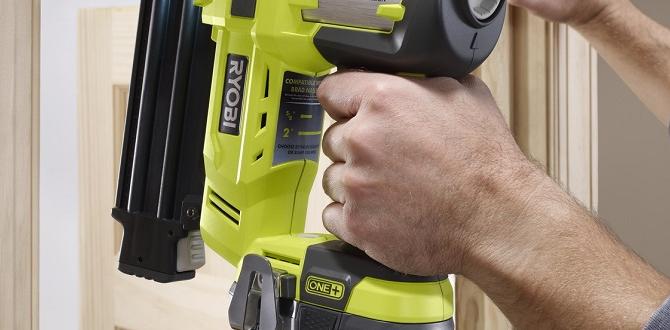
Choosing a Nail Gun for Beginners
Picking the right nail gun can feel overwhelming. Beginners often wonder, “What should I look for?” Start by considering the type of projects you’ll tackle. Will you work with wood or do renovations? Choose between electric, pneumatic, and fuel-powered options based on your needs. A fun fact: electric nail guns are quiet and easy to use, making them great for indoor work. Safety features and power settings matter, too. Finding the perfect nail gun could boost your confidence in DIY projects!Key Features to Consider
Adjustable depth settings and their importance. Safety features that beginners should look for.Beginners should look for key features in a nail gun. First, adjustable depth settings help control how deep nails go. This is important for avoiding mistakes and protecting materials. Second, safety features keep users safe. Look for items such as:
- *Safety switches*
- *Grip safety triggers*
- *Protective guards*
These features make a nail gun easier and safer to use. Remember, safety is the number one priority!
What safety features should beginners look for in a nail gun?
Beginners need to focus on strong safety features. Look for safety switches, anti-jam mechanisms, and grip safety triggers. These elements will help prevent accidents and injuries. Stay safe while you build!
Understanding Nail Sizes and Types
Common nail types used in nail guns (e.g., finish, brad, framing). How to choose the right nail size for different projects.Nail guns use different types of nails for various projects. Here are some common types:
- Framing Nails: Thick and long, used for big wooden structures.
- Finish Nails: Thinner, great for detailed work like trim and molding.
- Brad Nails: Very thin, perfect for delicate projects like crafting.
Choosing the right nail size is key. Bigger nails work for heavy jobs, while smaller nails suit lighter tasks. Always match the nail size to your project for the best results!
What nail size should I use for my project?
Use larger nails for framing and smaller nails for detail work.
Budget Considerations for Beginners
Price ranges of nail guns and what to expect at each level. Cost of additional accessories and maintenance.When it comes to getting a nail gun, think about your budget first. Nail guns can cost anywhere from $50 for basic models to over $300 for advanced ones. Each price range gives you different features. Lower-cost guns work well for light tasks, while expensive ones are great for big jobs. Don’t forget to budget for accessories like safety goggles and maintenance, which can add up quickly!
| Price Range | What to Expect |
|---|---|
| $50 – $100 | Basic models for small tasks |
| $100 – $200 | More features and better durability |
| $200 – $300+ | Heavy-duty and professional quality |
Buying a nail gun is fun, but keep your wallet in mind! You don’t want it screaming for mercy when you check out.
Ease of Use
Userfriendly features that make nail guns suitable for beginners. Importance of weight and ergonomics for handling.Choosing the right nail gun is key for beginners. User-friendly features can make a big difference. Look for models that have straightforward controls. They should be easy to handle and adjust. Also, consider the weight of the tool. A lightweight nail gun is easier to use, especially for longer tasks. Ergonomics also matter. A comfortable grip will let you work longer without tiring out.
- Easy controls help beginners learn fast.
- Lightweight models are simple to manage.
- Comfortable grips reduce hand fatigue.
What features should beginners look for in a nail gun?
Look for user-friendly controls, lightweight design, and a comfortable grip.Safety Tips for Using Nail Guns
Essential safety gear and practices. Common mistakes to avoid as a beginner.Nail guns can be fun, but safety first! Always wear protective goggles to shield your eyes from flying debris. Earplugs are also handy as nail guns can get loud. Remember, never point the gun at anyone, even if it feels like a toy. Common mistakes include forgetting to check the nail magazine and using the wrong pressure. Trust us; it’s better than a trip to the ER!
| Essential Safety Gear | Common Mistakes to Avoid |
|---|---|
| Protective Goggles | Pointing at yourself or others |
| Ear Protection | Using wrong nail size |
| Gloves (optional) | Ignoring the power source |
Common Projects for Beginners Using Nail Guns
Popular DIY projects that can be tackled with a nail gun. Tips for getting started on specific projects.Nail guns can make DIY projects a breeze. Many beginners find success with simple tasks like building a birdhouse or installing baseboards. These projects are perfect for practicing your skills. Want to impress your friends? Consider making a picture frame or a small bookshelf. A nail gun helps get it done faster—plus, you get the satisfaction of saying, “I built that!”
| Project | Tip |
|---|---|
| Birdhouse | Start with pre-cut wood to save time! |
| Baseboards | Measure twice, so you don’t nail yourself into a corner! |
| Picture Frame | Use finishing nails for a cleaner look. |
| Bookshelf | Ensure everything is level—nobody wants a wobbly shelf! |
With a nail gun, you can finish projects quickly and with style. So grab that tool and let your creativity soar—just keep your fingers away from the pointy end!
Conclusion
In conclusion, choosing a nail gun as a beginner involves considering tool types, safety features, and your project needs. Make sure to read reviews and compare options before buying. Remember, practice using your nail gun on scrap wood. This helps build your skills and confidence. For more tips, explore beginner guides and tutorials to enhance your experience!FAQs
Sure! Here Are Five Related Questions On The Topic Of Choosing A Nail Gun For Beginners:Choosing a nail gun can be fun! First, think about what projects you’ll do. If you have small tasks, a cordless nail gun is easy to use. If you want something for big projects, a bigger one might be better. Always remember to wear safety gear like goggles when using it!
Of course! Please provide me with the question you’d like me to answer.
What Are The Different Types Of Nail Guns Available For Beginners, And How Do They Differ In Functionality?There are a few types of nail guns for beginners. The first is a **pneumatic nail gun**, which uses air to shoot nails. This can be strong but needs a special air compressor. Then, we have **electric nail guns**, which plug into a wall or use batteries. They are easier to use and good for small projects. Lastly, there are **manual nail guns**, which you press down to drive in nails. They are the simplest but need more effort. Each type works differently and fits different jobs!
What Safety Features Should I Look For In A Nail Gun If I’M A Beginner?When choosing a nail gun, look for a safety tip that prevents accidental firing. A lockout feature is important too; it stops the gun from firing when not in use. You should also check for an adjustable depth control. This helps you control how deep the nails go into the material. Lastly, choose a model with an ergonomic design to keep your hands comfortable while you work.
How Do I Determine The Appropriate Power Source (Electric, Battery-Operated, Or Pneumatic) For My Needs As A Beginner?To choose the right power source, think about what you need to do. If you want to use something indoors, electric power might be best. If you need to move around a lot, a battery-operated tool could work well. For strong pressure jobs, like inflating tires, consider pneumatic tools that use air. Think about where you’ll use it and how much power you need!
What Nail Sizes And Types Are Recommended For Beginners Using A Nail Gun?For beginners using a nail gun, you can start with 1.5-inch to 2.5-inch nails. These sizes are often called finish nails or brad nails. They are good for small projects like fixing furniture or crafting. Make sure your nail gun matches the type of nails you choose. Always wear safety gear when using a nail gun!
What Are Some Essential Tips For Using A Nail Gun Safely And Effectively As A Beginner?To use a nail gun safely, always wear safety glasses to protect your eyes. Keep your fingers away from the front of the gun when firing. Make sure the gun is loaded correctly before starting. Practice using it on scrap wood to get used to how it works. Remember, never point the nail gun at anyone, even if you think it’s off.
{“@context”:”https://schema.org”,”@type”: “FAQPage”,”mainEntity”:[{“@type”: “Question”,”name”: “Sure! Here Are Five Related Questions On The Topic Of Choosing A Nail Gun For Beginners:”,”acceptedAnswer”: {“@type”: “Answer”,”text”: “Choosing a nail gun can be fun! First, think about what projects you’ll do. If you have small tasks, a cordless nail gun is easy to use. If you want something for big projects, a bigger one might be better. Always remember to wear safety gear like goggles when using it!”}},{“@type”: “Question”,”name”: “”,”acceptedAnswer”: {“@type”: “Answer”,”text”: “Of course! Please provide me with the question you’d like me to answer.”}},{“@type”: “Question”,”name”: “What Are The Different Types Of Nail Guns Available For Beginners, And How Do They Differ In Functionality?”,”acceptedAnswer”: {“@type”: “Answer”,”text”: “There are a few types of nail guns for beginners. The first is a **pneumatic nail gun**, which uses air to shoot nails. This can be strong but needs a special air compressor. Then, we have **electric nail guns**, which plug into a wall or use batteries. They are easier to use and good for small projects. Lastly, there are **manual nail guns**, which you press down to drive in nails. They are the simplest but need more effort. Each type works differently and fits different jobs!”}},{“@type”: “Question”,”name”: “What Safety Features Should I Look For In A Nail Gun If I’M A Beginner?”,”acceptedAnswer”: {“@type”: “Answer”,”text”: “When choosing a nail gun, look for a safety tip that prevents accidental firing. A lockout feature is important too; it stops the gun from firing when not in use. You should also check for an adjustable depth control. This helps you control how deep the nails go into the material. Lastly, choose a model with an ergonomic design to keep your hands comfortable while you work.”}},{“@type”: “Question”,”name”: “How Do I Determine The Appropriate Power Source (Electric, Battery-Operated, Or Pneumatic) For My Needs As A Beginner?”,”acceptedAnswer”: {“@type”: “Answer”,”text”: “To choose the right power source, think about what you need to do. If you want to use something indoors, electric power might be best. If you need to move around a lot, a battery-operated tool could work well. For strong pressure jobs, like inflating tires, consider pneumatic tools that use air. Think about where you’ll use it and how much power you need!”}},{“@type”: “Question”,”name”: “What Nail Sizes And Types Are Recommended For Beginners Using A Nail Gun?”,”acceptedAnswer”: {“@type”: “Answer”,”text”: “For beginners using a nail gun, you can start with 1.5-inch to 2.5-inch nails. These sizes are often called finish nails or brad nails. They are good for small projects like fixing furniture or crafting. Make sure your nail gun matches the type of nails you choose. Always wear safety gear when using a nail gun!”}},{“@type”: “Question”,”name”: “What Are Some Essential Tips For Using A Nail Gun Safely And Effectively As A Beginner?”,”acceptedAnswer”: {“@type”: “Answer”,”text”: “To use a nail gun safely, always wear safety glasses to protect your eyes. Keep your fingers away from the front of the gun when firing. Make sure the gun is loaded correctly before starting. Practice using it on scrap wood to get used to how it works. Remember, never point the nail gun at anyone, even if you think it’s off.”}}]}